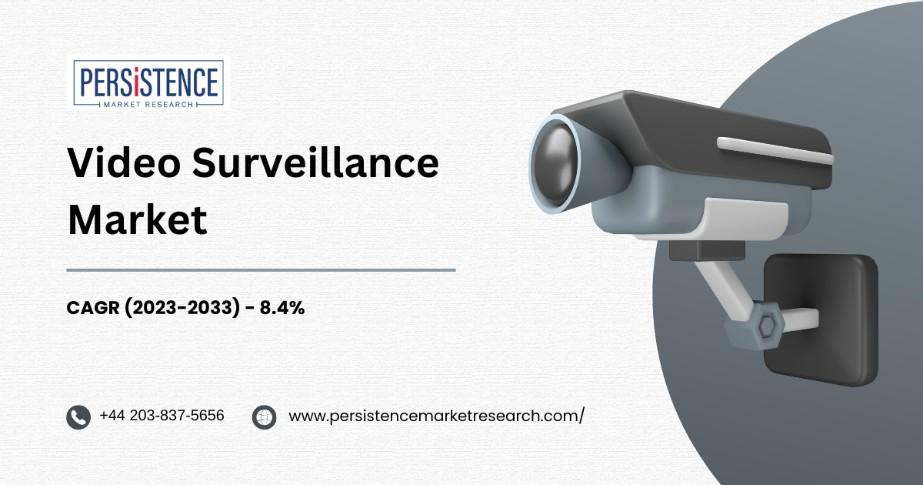Video Surveillance Industry Trends: What to Know and Prepare for
The global video surveillance market, valued at US$ 45,122.1 million in 2022, is projected to grow from US$ 48,190.4 million in 2023 to US$ 108,287.7 million by 2033, at a CAGR of 8.4%. This growth is driven by advancements in artificial intelligence and the increasing adoption of Video Surveillance as a Service (VSaaS), which integrates AI into vision-based systems. However, privacy and security concerns regarding video data pose significant challenges. Recent innovations include Axis Communications’ next-generation M11 Box Cameras and Hikvision’s TandemVu PTZ cameras, which enhance image quality and monitoring capabilities.

The video surveillance industry is undergoing significant changes driven by technological advancements and evolving market demands. As organizations and governments seek to enhance security and operational efficiency, understanding the latest trends and preparing for future developments is crucial. This press release highlights key trends in the video surveillance market and offers insights into how stakeholders can stay ahead.
Key Trends Shaping the Video Surveillance Industry
1. Artificial Intelligence (AI) and Machine Learning Integration
Overview: AI and machine learning are transforming video surveillance by enabling advanced analytics and automation. AI-powered systems can analyze vast amounts of video data in real-time, offering features such as facial recognition, object detection, and predictive analytics.
Implications: These technologies improve threat detection, reduce false alarms, and enhance operational efficiency. Organizations should consider integrating AI-driven solutions to stay competitive and meet evolving security needs.
2. Rise of Cloud-Based Surveillance Solutions
Overview: Cloud-based video surveillance solutions are gaining popularity due to their scalability, cost-effectiveness, and ease of management. Cloud platforms allow users to access and manage their surveillance systems remotely, reducing the need for on-site infrastructure.
Implications: The shift to cloud-based solutions offers greater flexibility and integration capabilities. Companies should explore cloud options to leverage their benefits and provide customers with modern, adaptable solutions.
3. Advancements in High-Resolution and 360-Degree Cameras
Overview: The demand for high-resolution cameras, including 4K and 8K models, is increasing as organizations seek better image quality and detail. Additionally, 360degree cameras are gaining traction for their ability to provide comprehensive coverage in a single view.
Implications: High-resolution and 360-degree cameras enhance surveillance effectiveness and reduce the need for multiple cameras. Businesses should invest in these technologies to offer superior image clarity and coverage.
4. Integration with Smart Technologies and IoT
Overview: Video surveillance systems are increasingly integrating with smart technologies and the Internet of Things (IoT). This integration enables more comprehensive security solutions, including smart city initiatives and connected devices.
Implications: The integration with IoT and smart technologies allows for more seamless and intelligent security solutions. Organizations should consider these integrations to enhance system performance and offer innovative solutions.
5. Focus on Data Privacy and Compliance
Overview: With the rise in surveillance data, there is a growing emphasis on data privacy and regulatory compliance. Organizations must adhere to regulations such as GDPR and CCPA to protect personal information and ensure data security.
Implications: Compliance with data privacy regulations is essential for avoiding legal issues and maintaining customer trust. Companies should implement robust data protection measures and stay informed about regulatory changes.
6. Emergence of Edge Computing in Video Surveillance
Overview: Edge computing involves processing data locally at the edge of the network, rather than sending it to a centralized server. This approach reduces latency and improves real-time processing capabilities for video surveillance systems.
Implications: Edge computing enhances the efficiency and responsiveness of video surveillance systems. Organizations should explore edge computing solutions to optimize their surveillance operations and reduce reliance on centralized data processing.
Preparing for the Future of Video Surveillance
To stay ahead in the rapidly evolving video surveillance market, stakeholders should consider the following strategies:
1. Invest in Research and Development (R&D)
Strategy: Prioritize R&D to stay at the forefront of technological advancements and develop innovative solutions that meet emerging market needs.
2. Adopt Flexible and Scalable Solutions
Strategy: Implement flexible and scalable surveillance solutions, such as cloud-based platforms and modular systems, to accommodate changing requirements and future growth.
3. Enhance Integration Capabilities
Strategy: Focus on integrating video surveillance systems with other technologies, such as smart devices and IoT, to provide comprehensive and cohesive security solutions.
4. Stay Informed About Regulatory Changes
Strategy: Keep abreast of data privacy regulations and industry standards to ensure compliance and protect customer data.
5. Explore Emerging Technologies
Conclusion
Strategy: Invest in emerging technologies, such as AI, edge computing, and highresolution cameras, to offer cutting-edge solutions and maintain a competitive edge.
The video surveillance industry is rapidly evolving, driven by technological advancements and shifting market demands. By understanding these trends and preparing for future developments, stakeholders can position themselves for success and meet the growing needs of the security and surveillance market.
